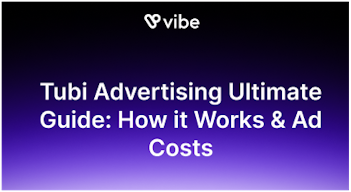Why is CTV a performance channel - and what does that mean?
We’ve been predicting it for a long time now, and it finally happened: CTV’s viewership share has officially surpassed broadcast and cable television’s. Meanwhile, Insider Intelligence predicts this year’s upfront CTV ad spend will grow by 34.6 percent to $6.41 billion—about as much as total CTV spend only three years ago. Between this monumental shift in consumer habits, increased transparency in attribution, and lowering CPMs, CTV advertising is ripe for an exponential acceleration in programmatic delivery models.
Here at Vibe.co, we’ve always looked at CTV as a performance channel and recent market accelerations are making the case even clearer. By “performance channel,” we mean one that delivers clear, trackable outcomes affecting your bottom line, which is what so many DTC (Direct To Consumer) brands, SMEs (Small and Medium Enterprises) and emerging e-commerce brands are laser-focused on today (as opposed to old school TV brand storytelling).
Let’s examine the top 3 reasons CTV became a core digital strategy channel: combining TV’s narrative power with the impact of digital delivery, unprecedented flexibility and transparency, and exponential scalability.
The case for CTV
First things first: what even is CTV?! Connected Television and its bedfellow OTT (Over The Top) refer to the TV device (for the former) and the content (for the latter) streamed over the internet to watch long form television programming. It encompasses SVOD (Subscription-based Video On Demand) streaming services like Netflix or Disney+ and AVOD (Advertising-based Video On Demand) streaming services like Hulu or Pluto TV. To most viewers, it’s just TV, but to advertisers it’s a brave new world that allows for granular digital targeting in a premium video format.
Early on, brands integrated CTV into their advertising strategies in the same way they would have worked with traditional broadcast networks, but as prices lowered, RTB (Real Time Bidding) machine learning matured, and reporting became more transparent, CTV emerged as a valuable net new channel in the digital marketing landscape, with the power to deliver measurable results.
CTV is an impactful performance marketing channel all along the marketing funnel: it drives brand awareness, but also delivers unprecedented consumer engagement with a 97% VTR (View Through Rate), all with the flexibility and median CPM rates usually associated with other digital channels. Most importantly, it places television advertising within the grasp of thousands of organizations and brands who never would have had the budgets or the staff to manage traditional linear TV campaigns.
Powerful TV storytelling meets targeted digital impact
Audience attention is at an all-time premium, as our post-pandemic screen-addled brains can only focus for as little as 8 seconds at a time, according to some studies. And while there is no denying how deeply transformational social media and display advertising have historically been, they will never yield the same level of attention as television advertising in a brand safe environment next to long-form premium content; especially as divisive UGC (User Generated Content) and muted content have become an increasing concern for digital advertisers.
Even more importantly, traditional digital channels are going through serious structural shifts leading to signal loss and rising CPMs (Cost Per Mille).The last year or so have seen increasing slow digital growth in the wake of Apple’s privacy changes, increasing regulation, and upcoming cookie deprecation. In fact, during an earnings call earlier this year, Meta announced a potential $10 billion loss this year due to privacy regulations and audience signal loss.
Of course the targeting, tracking, and cross-device measurement of digital remain incredibly powerful - they’re just having to develop new ways to work with wide-ranging privacy regulations. Meanwhile, because CTV technology operates by household IP rather than device IP, it isn’t subject to the same limitations while offering similarly granular results.
In fact, a recent Video Week report on the future of CTV cited exciting outcomes for brands adding CTV to their marketing mix:
“Our clients saw an increase in search volume and cost per click when they added CTV to their media mix. A bunch of our clients are starting to see experimentation opportunities in the campaigns they’re running on social media platforms, such as Facebook. Buyers can test results by content genre, network and, in some cases, even by title on CTV, which leads to really granular measurement when buyers layer audience and creative testing on top of that.”
CTV technology and consumer affinity have developed so quickly it can be hard to keep up: in just the last year, CTV audience targeting, inventory growth, delivery optimization, and incremental reach measurement have turned CTV into a true performance channel with the results to back it up. Meanwhile, audiences are also adapting to this new technology, surprising industry experts by flocking to AVOD streaming services instead of doubling down on long-time industry darling SVOD (of Netflix and Disney+ fame.) Not only do viewers not mind advertising on their streaming channels, a recent survey showed they perceive CTV ad breaks to be shorter, more relevant and better quality than linear TV advertisements. And because of this receptiveness, they’re more driven to take action. That’s the power of CTV advertising: it’s not just premium content on a big screen - it’s the exact content customers want to watch, at a time they picked. You couldn’t dream up a more engaged audience if you tried!
Ok, so the audience is there, but what about measurement and conversion? That might be the fastest growing technology in the CTV ecosystem! The development of 1:1 deterministic attribution processes is convincing an increasing amount of marketers to explore CTV as part of a performance-focused marketing mix. MMPs and other measurement partners are seeing - and reporting - incremental reach, assisted conversions, and Multi Touch Attribution customer journeys in a way that can finally show the true value of each digital channel in your strategy.
Audiences are putting in the work too, by interacting with TV ads in unprecedented ways, mainly thanks to a behavior recently dubbed “dual screening.” Over 93% of CTV audiences stream content with a second screen in their hand, sometimes even using their phone as a remote control. With their smartphones, users can comment on what they see, look things up, engage with an interactive ad on the screen, or scan a QR code so marketers can identify consumers who are actively interested in the campaign and retarget them based on email or phone data.
Finally a flexible, transparent channel
If nothing else, the last few years have shown us that flexibility and innovation are crucial for any robust advertising strategy; but how can you confidently experiment when the results you’re working with are either too vague (linear TV), too late (linear TV), or untrustworthy (digital walled gardens like Meta or Google)?
At Vibe.co, we believe in testing early and testing often. That’s why it is crucial to our mission that CTV marketers working on our platform receive real-time feedback as soon as their campaign launches, with no money down and affordable CPMs. What’s even better? Real-time campaign results are segmented by targeting vertical (age, channel, location, gender, etc.) and KPI (completion rate for branding, VTRs, total reach, unique households exposed, viewability, cross-channel reach) so advertisers can optimize their campaigns as they are running - with no interruption.
In fact, advanced data targeting and tracking are the main reasons advertisers plan to increase their CTV spend in 2023. According to a recent Audience Express survey, almost nine in 10 marketers plan to increase their investment in these channels as they aim to reach their audiences through premium video inventory. Some industries are especially focused on direct response marketing and agile campaign features. Direct To Consumer (DTC) brands, for example, are making a strong move away from walled gardens, especially now that they can use real-time insights from CTV dashboards to test and iterate digital video campaigns. Because they operate mostly online, many DTC brands lean into direct response marketing, where conversions can be more easily tracked, making the move over to CTV extra simple.
But does it scale?
The short answer? Yes. As we mentioned earlier, walled gardens are losing their appeal as more transparent and scalable solutions emerge. There’s a big, wide open market out there, and the challenge of scale which has forced advertisers into the arms of expensive walled gardens like YouTube and Amazon is finally being addressed. Smart TV manufacturers, publishers, and streaming services are aggregating content that can’t be accessed elsewhere and making it highly discoverable, massively simplifying campaign targeting and delivery.
Meanwhile, on the audience side, demand is booming. AVOD is the fastest growing model in the fastest growing digital channel (CTV) while SVOD is a saturated market that’s hitting a serious plateau. That’s why Vibe.co offers programmatic delivery focused on performance, so clients can scale their campaigns and optimize their CPMs. How? By enabling television advertisers to deliver campaigns on multiple premium apps channels in just one “deal,” or campaign strategy, with ads optimized for incremental reach,1st party audience retargeting, and more.
Unlike linear TV which is planned and bought using panel-based data, programmatic CTV advertising is bought on an impression-by-impression basis via an auction. That’s why the CTV platform you choose to work with must absolutely have a well-developed bidding tool that they are willing to tell you more about. Vibe.co’s proprietary bidder, for example, has been in R&D for over 4 years which is why our CPMs are at or below traditional digital channel levels. Once advertisers hit that programmatic auction sweet spot, there is virtually no limit to campaign scale.
How to get started
Now that we’ve established CTV is powerful, flexible, transparent, and scalable, here are some best practices to keep in mind before launching your first CTV campaign.
- Don’t be afraid to experiment. The Vibe.co platform allows advertisers to segment each campaign into as many ad sets as needed for easy A/B testing and creative experimentation.
- Use early campaign insights to your advantage. Yes, it can be frustrating to have to tweak a campaign your team worked hard on, but real-time reporting offers unprecedented insight into targeting and deliverability/ - don’t ignore it out of convenience!
- Don’t forget about audio. If you are used to social ads, you already know how to create impactful graphics, but sound is an intrinsic part of TV advertising - make the most of it!
- Track the right KPIs! Vibe.co enables pixel tracking (for impressions, leads, and/or purchases) and/or MMP integration so you never have to wonder how your campaign is actually performing.
- Pick partners wisely. Work with a simple, transparent platform that allows you and your team to develop true ownership over your CTV campaign performance.


